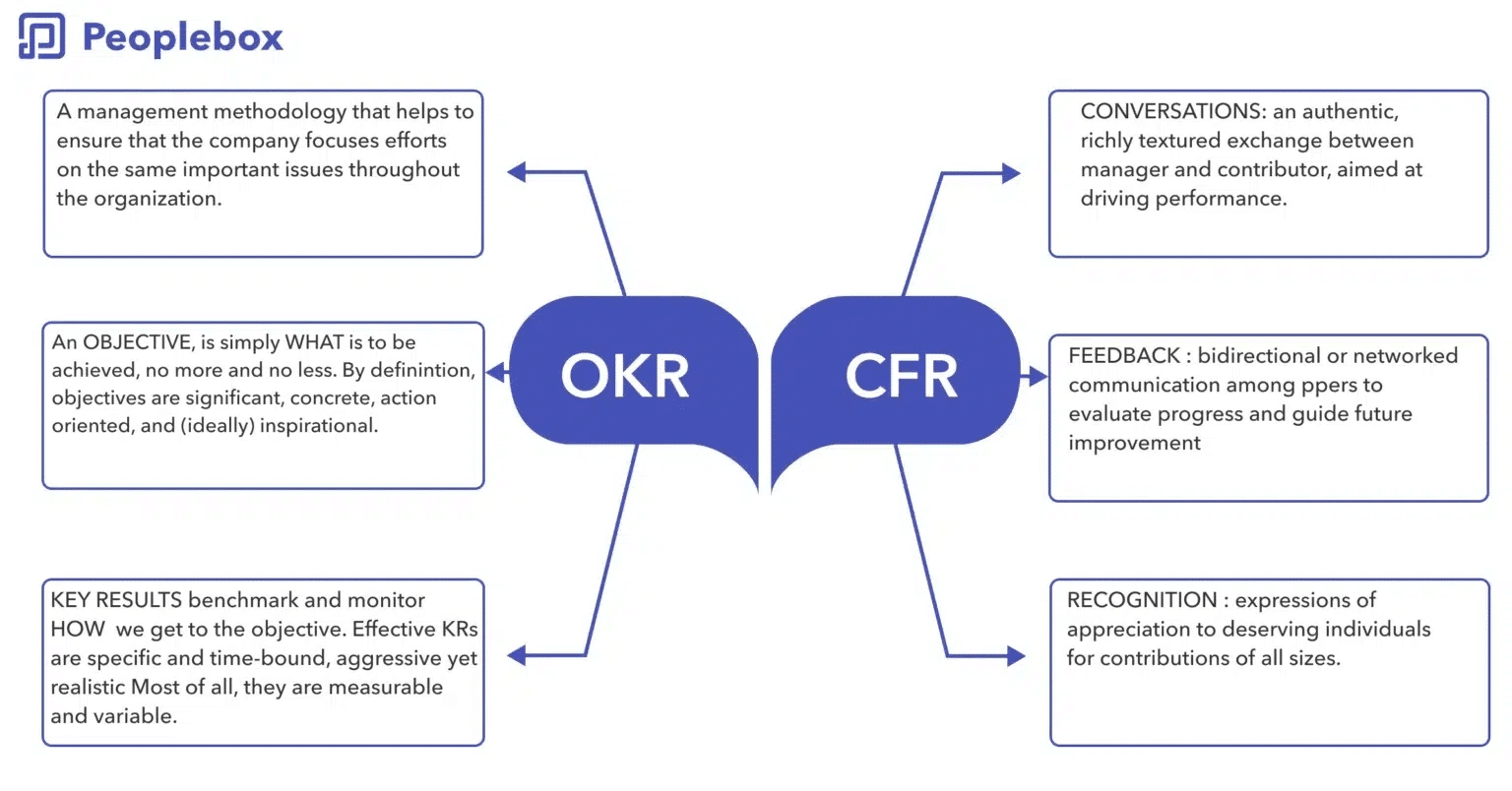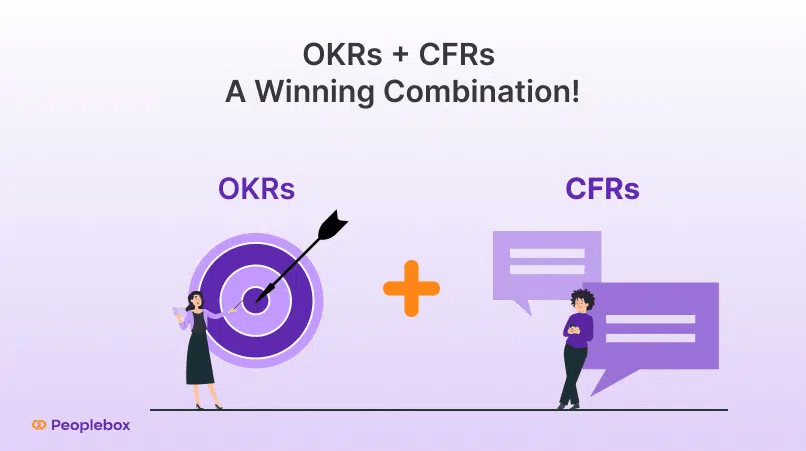Objective & Key Results (OKRs) in combination with Conversations, Feedback, and Recognitions (CFRs) gives an edge over any traditional Performance Management System.
OKRs and CFRs
OKRs are the secret ingredients that many successful companies swear by.
The latest advancement in performance management focuses on combining this powerful tool with CFRs, a complementary method to ensure a higher success rate.
OKRs are a simple system of goal setting. They define the primary “Objective” of the company and make sure that every employee of the organization is focused and determined to achieve it. “Key Results” describe the progress in a specific time frame.
The most astounding feature of OKRs is scalability and their effectiveness and applicability when applied to different settings. This means that it is possible to apply the concept of OKRs to groups, organizations, and even individuals.
CFRs, on the other hand, work as the “delivery system” of OKRs. They are meant to ensure that the employees remain motivated towards the “Objectives” and prepare for future goals by brushing their skills.
Therefore, together OKRs and CFRs become a formula for successful performance management in an organization.
OKRs for defining engagement priorities

Clearly defining the role and responsibility of every employee in an organization helps them set their priorities for better management of their work. This leads to increased work engagement and also avoids overlapping of work.
OKRs offer a practical approach to help employees understand the ultimate goal of the company and how their individual performances affect that goal.
So, the employees can determine their priorities by aligning them with the company’s “Objectives”.
This in turn allows the employees to relate their individual work with the company’s progress thus, motivating them to work with their maximum potential.
However, the fast-changing business markets and modern start-ups require more than just setting priorities and determining goals.
They require a continuous system that works towards improving performance instead of becoming the organization’s annual ritual. OKRs and CFRs together provide a solution to their problems.
“What gets measured gets managed”
– Peter Drucker
The start-ups today need a system that complements OKRs and ensures better performance management and employee engagement.
Conversations, Feedback, and Recognition (CFRs) have been found useful in building this system of continuously managing performance and thus, boosting outcomes.
Difference between OKRs and CFRs

OKRs and CFRs together form a powerful tool for keeping teams as well as individuals motivated and aware of their real-time progress. However, even when they complement each other, there are certain differences between OKRs and CFRs.
The main difference is the measurement scale on which the metrics or objectives are measured. OKRs measure an organization’s strategic goals that must be completed within the set time duration.
On the other hand, CFRs work toward smaller individual and organizational goals than OKRs that are expected to be achieved in a relatively shorter time frame.
Moreover, characteristically OKRs can only be graded as “complete” or “incomplete” at the end of the term while CFRs offer a wider vocabulary to express the progress made towards the goals.
OKRs and CFRs when used together, it is often advised to use CFRs throughout and also at the end of the OKR cycle.
How CFRs and OKRs work together

“When performance is measured, performance improves. When performance is measured and reported back, the rate of improvement accelerates.”
Pearson’s Law
In OKRs objectives are meant to represent goals while key results provide the metrics for measurement of these goals.
CFRs help in better implementation of OKRs in an organization through regular performance conversations and frequent goal check-ins. John Doerr has rightly called them siblings in his book “Measure what matters”.
Both OKRs and CFRs complement each other in creating a work environment with enhanced transparency and accountability.
Moreover, they are inclined towards empowering employees and encouraging teamwork at all levels of an organization.
Appreciation is one of the most loved forms of expression for human psychology. When you appreciate an employee you are actually motivating them to unleash his best performance.
Recognition is the best way to make an employee feel appreciated Also, it encourages other employees to perform better.
CFRs and OKRs together create a system of continuous recognition of outstanding performances.
This system is a potent engagement driver. It can be implemented through peer-to-peer recognition, sharing recognition stories, and even tying recognition to organizational goals and strategies.
CFRs are directly related to measuring and improving performances. The main ingredients of CFRs are explained below:
1 Conversations
Regular meetings and discussions about OKRs are a must to stay focused on the pre-decided schedule. Genuine and richly textured conversations between the contributor and manager enhance efficiency.
These conversations are meant to provide proper guidance to the employee as well as understanding and providing for their needs.
Focusing on future improvement and avoiding negative criticism should be the core of these conversations.
The 1:1 conversations or those held in small groups containing people comfortable with each other are considered the best.
2 Feedback
The feedback process gives you and the employees an opportunity to discuss every aspect with clarity. The shortcomings can be pointed to using a positive tone and reasoning.
Also, suggestions can be provided to overcome any issue. Feedback should be non-risky and constructive.
3 Recognition
The acknowledgment of an employee’s contribution to the organization through his outstanding performance is essential.
It is the expression of gratitude for their loyalty and service, as well as a motivation for them to continue with good work in the future.
This gives the employees a sense of confidence and makes them strive for their highest performance. Also, they feel close and related to the organization.
Owing to the remote working situations that prevail today, it has become difficult to have proper meetings and discussions.
However, we suggest using video calls or any other interactive techniques to stay in touch with your employees.
This would keep them engaged with their work and develop a sense of belongingness.
How CFRs and OKRs together contribute to performance management?
OKRs play a vital role in measuring and improving performances. These work as an indicator that helps you track the progress made towards your goals.
However, sometimes the most powerful of warriors need support. In today’s scenario when business models and customer needs keep fluctuating frequently, OKRs should be supported with CFRs.
This is especially true in start-up scenarios where every single employee and every little mistake counts. Therefore, it becomes extremely important that you do not let your employees lose their morale.
Hence, using continuous conversations, feedback, and recognition will help them stay on track and motivated to achieve their goals.
CFRs along with OKRs are capable of establishing a system of continuous performance management.
They also work towards eliminating bias and encourage the managers to become mentors. Furthermore, they are an excellent way to track the practicability of OKRs and save them from falling.
When properly implemented, OKRs and CFRs enhance teamwork, create environments of success, and deliver the best possible results.
Run CFR sprint

Ideas are easy. Execution is everything. It takes a team to win.
-John Doerr
OKRs and CFRs when used together are capable of driving a business towards success with greater speed.
They maintain transparency and track progress. However, it can be difficult to incorporate CFRs in an organization that has been running only on OKRs for a long time.
CFR sprint can be used in such a scenario to help the employees adapt to changes.
There are multiple models of CFR sprints that can be created based on the need of a particular organization.
The nature of the industry, the number of employees, and the ultimate target required to be achieved define the plan for the CFR sprint.
However, there are certain core elements included as a part of every CFR sprint. They are:
360-degree feedback
Feedbacks are the most important part of any performance management system. Therefore, it becomes equally important to create a work culture where feedback is welcomed and taken positively.
The management should encourage peer-to-peer review where the employees are encouraged to assess each other’s performances regularly and provide unbiased feedback.
This would help in including feedback as part of regular discussions and team meetings instead of looking at them as an annual process accompanied by appraisals.
Tools for communication & recognition
These are one of the most underestimated and often ignored elements. However, we strongly suggest investing in the right tools and platforms that become your partner in managing regular communication with your employees.
This will help you in resolving their problems and motivating them towards their goals.
These tools also help you gauge and recognize the outstanding as well as low performers. So, you can decide which of your employees deserves an appraisal and which one needs your support.
These serve as an excellent approach to recognizing and appreciating the efforts and hard work of your employees.
Employee Recognition Platforms
Keeping track of the performance of every employee is more than difficult, especially in a start-up scenario where a number of employees are handled by one single person without much help or guidance.
The platforms are meant to collect employee performance data from different sources and compile it to give a clear picture of the top performers, so you can reward them.
As per a survey, 85% of the managers believe that recognizing the hard work of their employees motivates them to perform better.
Conclusion
Several leading Companies today are using OKRs and CFRs in combination for the progress of their business.
If their opinion is to be believed this new system has brought immense positive changes to their workplace.
When properly implemented, OKRs and CFRs together have proved to be capable of creating a framework that allows continuous performance management of employees leading to more recognition and work engagement.
A number of tools and platforms are available to help businesses optimize OKRs and CFRs for their organization. These are meant to make it convenient for people to adapt to changes. You will be doing yourself and your business a favor by investing in these tools.








